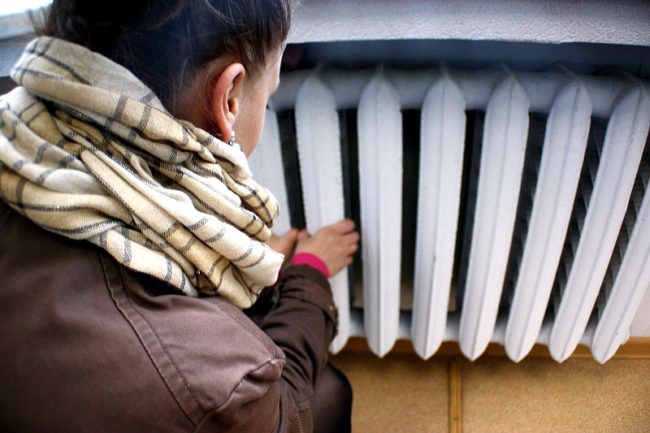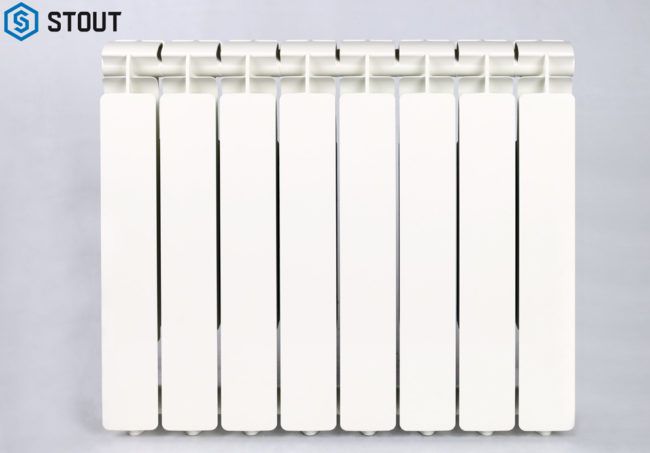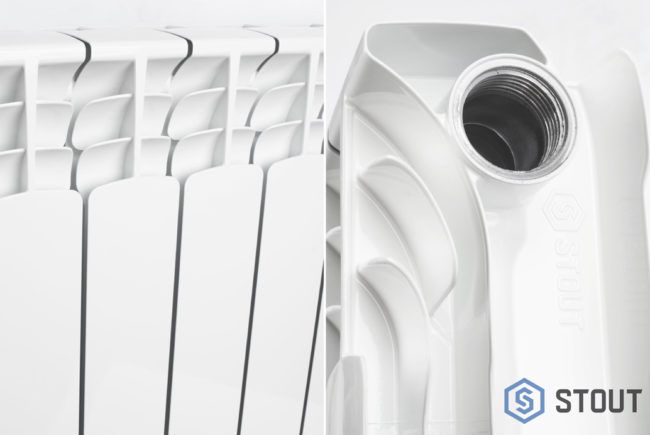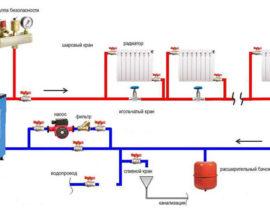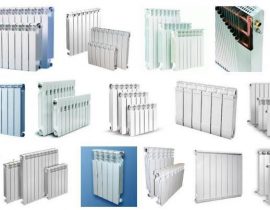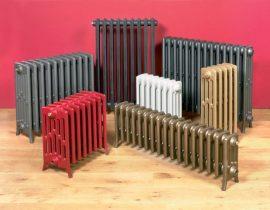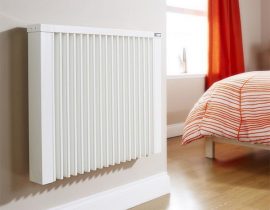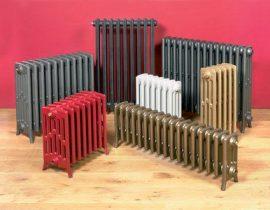When starting a major overhaul in a house, or equipping a heating system from scratch, a reasonable question arises, which radiators will better perform their direct function in an apartment? In modern stores today there is a huge selection of radiators.
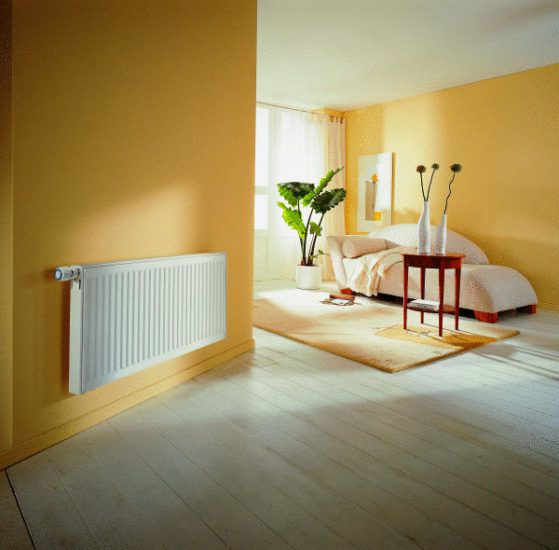
Heating radiators on the blank wall of the apartment
But according to what characteristics should they be selected? In this article, we will look at the main types of heating radiators and help you decide which ones are better to use in an apartment in terms of efficiency and a comfortable microclimate.
In this article, we will compare the main technical characteristics of heating units, compare them with the requirements of a central and autonomous heating system, and determine which option will be the most economical and efficient.
Content
- Features of the central heating system and why it is important
- Types of radiators most often used in apartments
- Video: design features of steel panel heating radiators
- Video tips for choosing a bimetallic radiator for an apartment
- How to choose the best radiator for an apartment?
- Brief description of radiators
- Video instruction for choosing heating radiators for an apartment
Features of the central heating system and why it is important
The requirements for choosing one or another radiator are mainly formed by the heating system. Most apartments in our country are served by a central heating system, which has a number of its pros and cons.
If apartments in your house are connected to a single central heating system, then the heating unit must be selected taking into account its technical features. First, let's define what a central heating system is.

Central heating system
- The thermal central unit generates heat, which is transported through the main lines to the apartments and returned back. The circulation is carried out in a closed circle due to the operation of pumps. Depending on the complex of equipment, the operation of the central system may be different, but on average, the pumps create a load of 16 working atmospheres. Accordingly, when choosing heating units for apartments with a central heating system, it is necessary to pay attention to the technical characteristics of the radiator for this parameter. The technical passport of the unit must indicate the maximum allowable pressure.
- The coolant does not work with the same pressure. The pressure drop creates water hammer, which negatively affects not only the efficiency of heat transfer, but also the duration of the service life.
- The water temperature is also not constant.Either the batteries are cold as ice, or the public utilities accelerate them to the maximum temperature, trying to catch up with the average monthly rate. Such a temperature difference adversely affects the condition of pipes and batteries.

The central heating system sometimes “sins” with temperature changes
- In any central system, accidents, technical water drains, etc. happen. Therefore, the radiator for the apartment must withstand such operating conditions.
- Another stumbling block for many modern radiators is the quality of the coolant. The fact is that most thermal units are produced for the EU countries, where water quality standards are much higher than ours, domestic ones. The material from which these products are made is simply not designed for the composition of the water that is often allowed through our pipes. The water contains a large amount of debris, lime, rust, stones. At high pressure, these substances quickly wear out the inner shell of radiators, significantly reducing their service life.
- It is necessary to take into account the connection of materials. You can purchase the highest quality and most expensive radiators, but if you connect them to pipes that are incompatible in material with the unit itself, this will not only significantly reduce the efficiency of the heating system, but can also cause batteries to fail.
As you can see, the central heating system makes rather high demands on the quality of radiators. Many modern batteries are simply not designed for the quality of the coolant that runs through the pipes and the pressure created in the pipes.
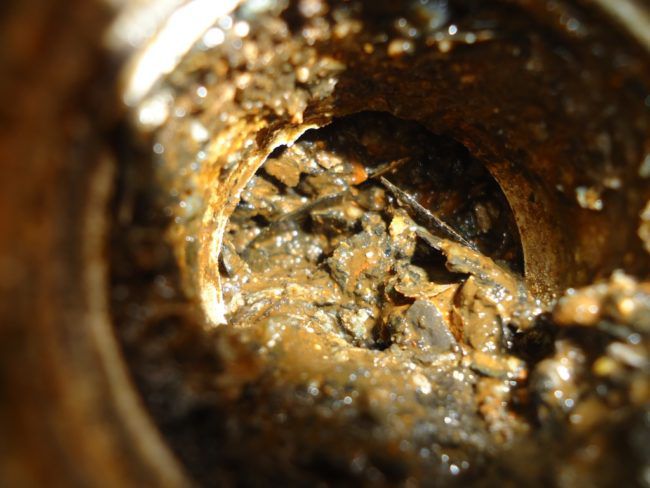
Low quality coolant
After we have clearly formed the features and operating conditions of batteries in apartments with a central heating system, we can proceed to their selection.
Types of radiators most often used in apartments
Today, a wide variety of heating devices are presented on the market, which differ in appearance, material and technical parameter. As a rule, it is the material that determines the main differences between radiators.
- Cast iron.
- Aluminum.
- Steel.
- Bimetallic.
- Copper.
Cast iron radiators: which is better to choose?
This type of battery is familiar to all of us, if only because absolutely all Soviet apartments previously had bulky cast-iron batteries.
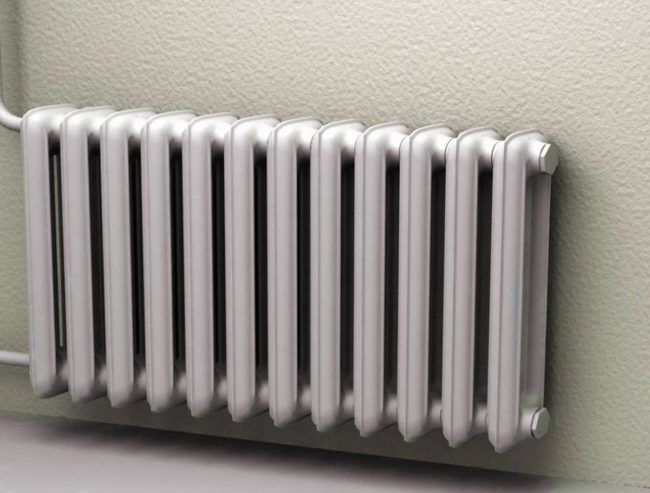
Soviet iron batteries
But today, these heavy, standard-sized structures painted with enamel paint are a thing of the past. They are replaced by stylish counterparts.
More stylish, powerful and efficient, today they seriously compete with modern counterparts. Cast iron has excellent thermal conductivity, it heats up for a long time, but at the same time it cools down just as long. Even after the temperature in the system drops or even after the coolant is turned off, such a battery will give off its heat for some time.
The residual heat retention number of cast iron radiators is 30%, which is twice that of steel and aluminum products.
Cast iron is a very durable and reliable material that can withstand a working pressure of 25-30 atmospheres. Given the average of 16 atmospheres, such batteries are not afraid of even powerful water hammer and failure of the central coolant.
Another feature of cast iron batteries is their versatility. They can work with pipes of any material.Thus, when purchasing cast-iron radiators for an apartment, you will not need to change the entire piping system.

Cast iron batteries have a universal connection
As for the quality of the coolant, cast iron batteries are perhaps the most unpretentious in this regard. A thick layer of cast iron is not subject to corrosion, which means that such radiators will last for decades in an apartment where the pH of the water fluctuates between 7-9 units.
As a result of prolonged interaction with water, a black precipitate gradually forms on the inner shell of the cast-iron radiator. It is he who creates a protective film that prevents the penetration of oxygen to the metal. If all technical standards of operation are observed, then the failure of cast-iron batteries due to metal destruction is extremely rare.
Modern cast iron radiators are coated on the outside with a special protective paint at the factory. At home, there will no longer be a need to paint them every year.
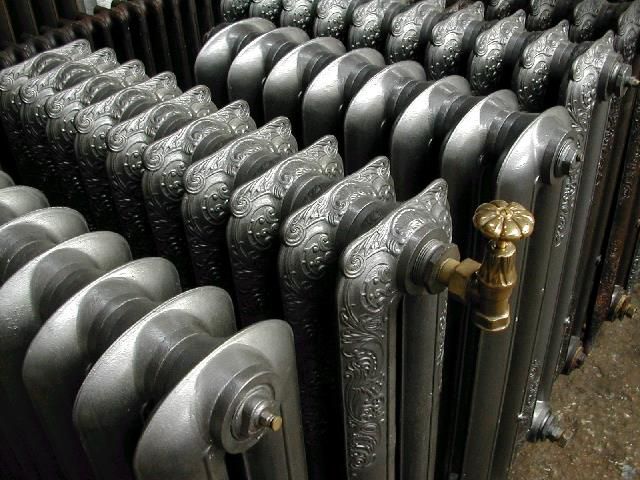
Modern cast iron radiators are painted at the factory with a special paint.
The smooth surface makes it easy to clean and dust does not accumulate on them. In addition, cast iron batteries practically do not form gases, which guarantees easy maintenance. There is no need to constantly bleed air by removing air pockets.
If earlier, in Soviet times, it was possible to purchase cast-iron batteries of only one size, today manufacturers offer a wide variety of these units, distinguishable in size and appearance.
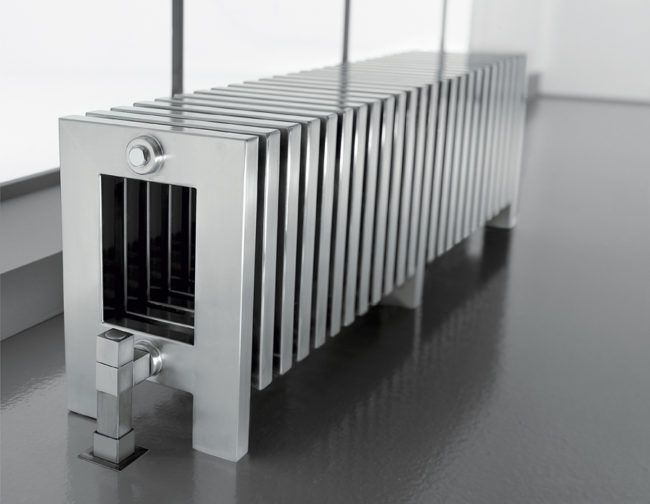
Stylish cast iron batteries
This will greatly expand your choice, helping you to choose stylish radiators for the design of the room and for creating the optimal temperature regime in the room.Foreign manufacturers offer very original design solutions in retro style, decorated with ornaments and castings.
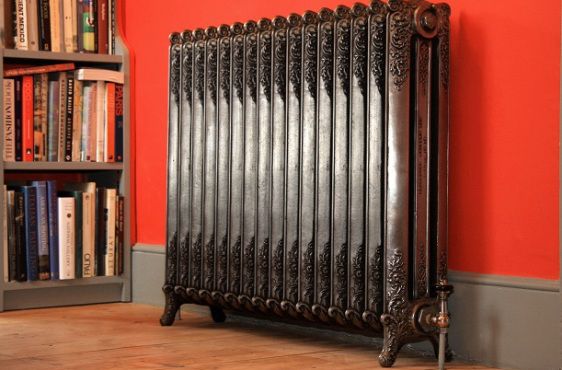
retro design cast iron radiators
Depending on the size of the room, the cast iron structure can be built up. The required number of sections is selected based on the following parameters: the number of windows, doors, room area and climate zone. If in domestic designs the filling volume is 1.3 liters, then foreign companies offer cast-iron radiators with a volume of 0.8 liters. The most popular foreign manufacturers that offer the best value for money on the domestic market today are Konner, Roca, Demir, Guratec, Retro Style, Demir Docum. Russian and Belarusian MS-140 and BZ-140 batteries are not inferior in performance, but their price will be 2-3 times lower than foreign manufacturers.
If earlier, to install a cast-iron radiator, it was necessary to hammer a powerful bracket into the wall, damaging the finish, today many manufacturers produce stylish floor-mounted radiators.
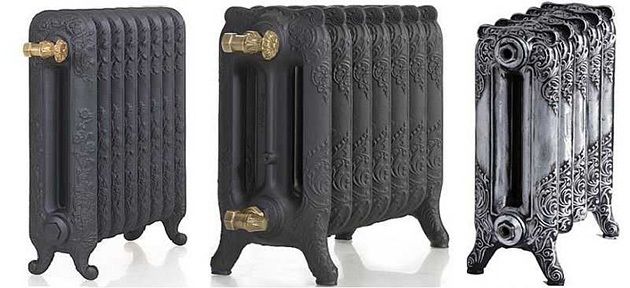
Floor mounting of cast iron batteries
But, speaking of cast-iron batteries, it would be unfair not to mention some of their shortcomings. These products are extremely heavy, which greatly complicates their installation. To mount the battery to the wall, you need to use bulky brackets, which does not always fit into the overall style concept of the room. In addition, no matter how stylish they are, not all products made from this material will fit into the modern design of the apartment.
Cast iron has a very weak inertia. Yes, it cools down slowly, but this is not always an advantage.With such a radiator, it will not be possible to quickly adjust the optimal temperature in the room. For houses with an individual heating system, it is this property of cast-iron batteries that can become decisive. The operation of such products will turn out to be too expensive.
So, summing up, we highlight the main pros and cons of cast iron batteries:
Pros:
- low cost;
- high strength and reliability;
- versatility and compatibility with pipes of different materials;
- simple operation;
- low requirements for the quality of the coolant;
- corrosion is not formed;
- long-term operation.
Minuses:
- big weight;
- weak inertia;
- installation complexity.
If you still decide to independently install cast-iron batteries in your apartment, then step-by-step instruction will help you get it right.
Aluminum heating radiators, which are better for an apartment?
Despite the stylish design and attractive appearance, this is not the best choice for apartments with a central heating system. At least in our country. The fact is that aluminum, due to its natural characteristics, is a very thin material subject to corrosion. And, given the low quality of the coolant in our heating systems, already after 5-7 years of operation, these radiators may fail or their efficiency will decrease.
In apartments with autonomous heating, such designs are very popular due to their high heat transfer and stylish appearance.
Today, one of the most interesting manufacturers of aluminum heating radiators in terms of "price / quality" is the STOUT brand.Products are made in Italy, they are adapted specifically for operating conditions in Russia, they are suitable for working with antifreeze, they have a modern design in Italian traditions, a 10-year manufacturer's warranty.
In this case, aluminum batteries can last at least 20-25 years, delighting owners with their functionality and beautiful design.
Aluminum batteries are designed for an operating pressure of 15-20 atmospheres, which is quite suitable for a central heating system. But the main danger lies in the low resistance to water hammer, which our systems sin with. In addition, the test pressure figure stated in the passport is often far from reality in reality, and such radiators can normally function at an operating pressure of only 12 atmospheres.
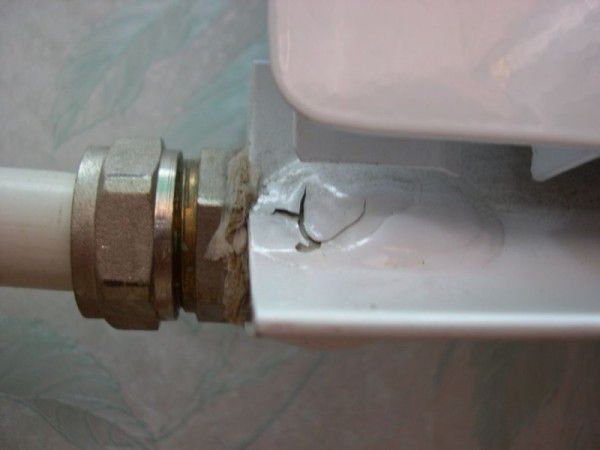
The consequence of water hammer on the radiator
If the choice still falls on aluminum batteries, then experts recommend installing conical valves on heating pipes. This will gradually increase the pressure of the coolant in the system.
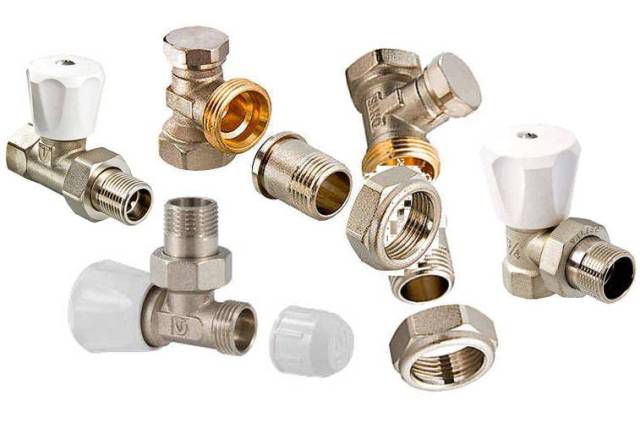
Shut-off valves
In addition, aluminum radiators have very strict requirements for the quality of the coolant. Normally, they will be able to function only with a Ph index of 5-6 units, which is far from the realities of domestic coolants.
Given the light weight of the structure, installation is not difficult even for one person. But here, too, some features must be taken into account. When connecting to the heating system, do not use brass, copper or steel fittings. When interacting with these types of metal, corrosion occurs in aluminum.Therefore, ideally, aluminum batteries should be connected to plastic pipes using grounding. The fastening of the structure with the system occurs by the method of threaded coupling.
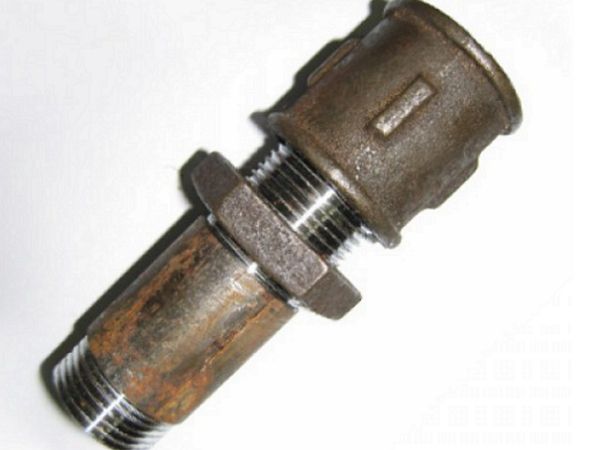
Union threaded connection
In the central heating system, there is a high oxygen content in the coolant. Reacting with aluminum, oxygen is converted to hydrogen gas, which causes unpleasant sounds in batteries and the formation of air pockets. One airlock can paralyze the operation of the entire system, therefore, in such radiators, a Mayevsky valve (air regulator) must be installed without fail so that air can be manually bled.
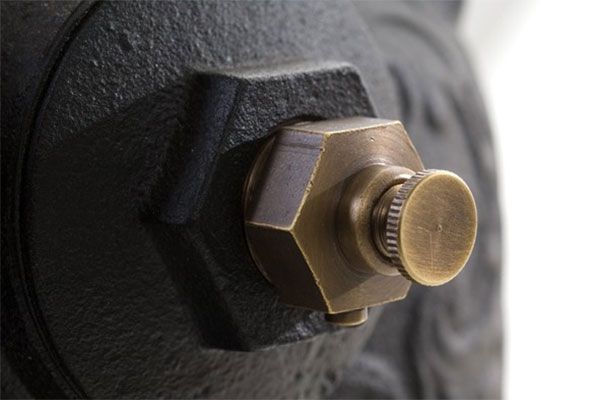
Mayevsky crane
Aluminum has the lowest inertia of all metals, which provides it with a very high heat transfer. It is 200-210 W per 1 section of the battery, while the volume of each section is only 400-450 ml of water. These batteries are mainly designed for an operating temperature of 70-80 degrees. The maximum is - 90 0 FROM.
There is a wide range of aluminum radiators on the market today, which differ in design, shape and size. The standard distance between the upper and lower axis of the device can be 250, 350 and 500 mm. But if the parameters of the apartment allow, then you can order a non-standard size of 700-800 mm.
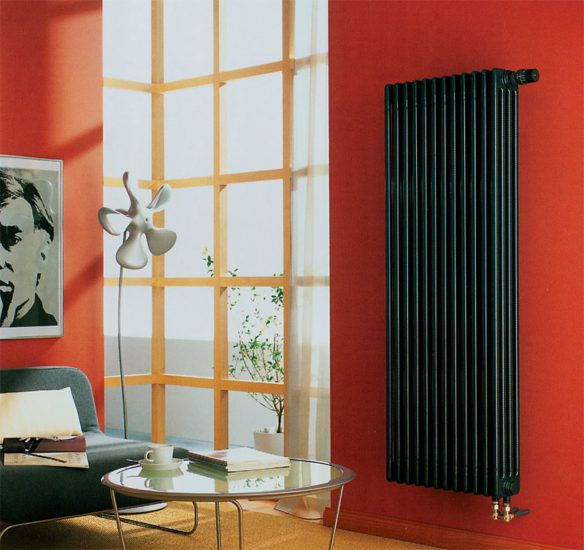
Non-standard sizes of aluminum radiators
Aluminum radiators are perfectly "friends" with various types of thermostatic devices, so it will not be difficult to choose a device that will allow you to regulate the optimal temperature in the house.
This type of radiator is made from an aluminum alloy and various silicon additives that increase the technical properties of the units, but in two completely different ways: casting and extrusion.
The injection method involves the manufacture of each section separately. An alloy of metals is poured into a special mold, which ensures perfect tightness of each section. This increases their working pressure to 16-18 atmospheres. During production tests, a test pressure of 22-25 atmospheres is created in the system, which indicates a large margin of safety for the product. For better heat dissipation, cast products generally have a smooth surface, which greatly simplifies the maintenance of the structure.
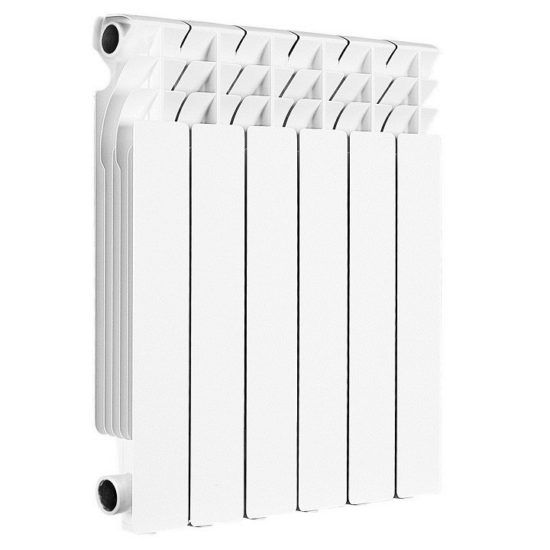
Aluminum batteries have a smooth surface
Aluminum radiators made using extrusion technology are several times cheaper, but at the same time they are inferior in technical characteristics to their cast counterparts. Here, as a raw material, already secondary (recycled) aluminum alloy with silicon additives is used. A lower composition suggests the presence of additional impurities, which increases the brittleness of the metal and reduces its resistance to corrosion.

Extrusion Technology
Extrusion technology involves forcing individual sections of the product through special nozzles. Then these sections are assembled into a finished structure, but during operation it will not be possible to increase or decrease the size of the unit.
pros
- light weight (they are almost 4 times lighter than cast iron products);
- simple installation;
- stylish appearance;
- variety of colors and sizes;
- low price;
- high heat dissipation.
Summarizing the disadvantages of aluminum radiators, I would like to once again emphasize that all these disadvantages appear precisely when installed in apartments with a central heating system. In houses with autonomous heating, these shortcomings will not be of such importance.
Minuses
- low resistance to hydraulic shocks of the system;
- high requirements for the quality of the coolant;
- hypersensitivity to various abrasive substances in water;
- working pressure should not exceed 12 atmospheres;
- frequent "airiness";
- low service life.
Summing up, we can conclude: despite their compactness, neat appearance and light weight, aluminum radiators are not the best choice for apartments with a central heating system.
Another separate item in aluminum units can be distinguished products with anodized coating. They are also made from a high-quality alloy of purified aluminum and silicon compounds, but the surface of the devices is covered with an oxidized anode.

Anodizing aluminum radiators
During the production process, aluminum changes its structure several times, which significantly increases its wear resistance and resistance to corrosion. Such batteries are not afraid of the aggressive environment of even low-quality coolant.
Anode batteries are produced by casting, and already finished sections are assembled into a common design using reliable seals and a threaded coupling. The advantage of such units is that they can be disassembled to remove a damaged section or to build up any battery size.
The inner surface of anodized radiators has a perfectly smooth structure, which significantly increases the efficiency of heat transfer.The coolant circulates freely inside the structure, and the operating pressure can reach up to 20-25 atmospheres.

Anodized Batteries
But with the purchase of anode batteries, you need to be extremely careful. Indeed, in their appearance, they are no different from ordinary cast aluminum radiators. Only a passport and a quality certificate can indicate the chemical composition of the material. Therefore, you need to purchase such products, which are distinguished by a high price, only from trusted sellers.
Anodized batteries are also perfect for apartments with central heating. The high price quickly pays off due to long-term operation, good efficiency and heat dissipation of products.
Steel radiators, is it the right choice?
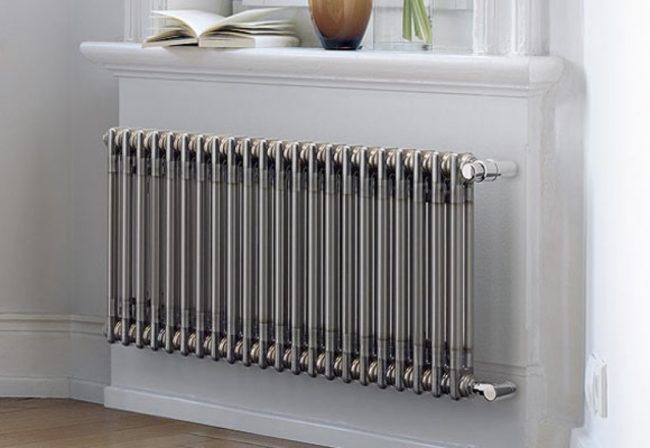
steel radiator
Modern steel batteries differ from each other not only in design, but also in construction. There are two types of such batteries: tubular and panel. To understand which version of steel batteries is better to purchase for an apartment, let's look at the features of each design separately.
Panel steel batteries
This type of radiator consists of two ribbed plates, produced by casting, inside of which there is a hermetically welded circuit. It is he who is filled with a coolant and provides the supply of hot air to the apartment.
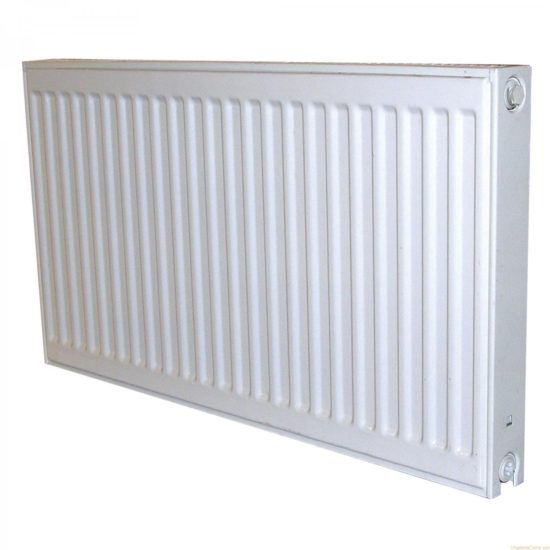
Panel steel radiator
The ribbed shape of the steel battery provides efficient heat transfer and circulation of warm air inside the room. Steel has the same thermal conductivity as cast iron. But unlike the thick walls of cast-iron radiators, steel units warm up much faster. In order to warm up a cold apartment from scratch, they will need 2 times less time.This high performance is achieved due to convection, which accounts for almost 50% of thermal radiation.
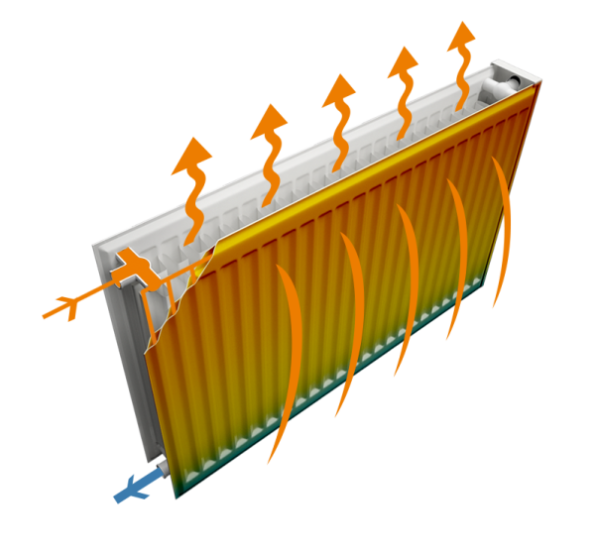
Convection ensures high performance
Steel batteries are designed for an operating pressure of 10-11 atmospheres, which is quite suitable for a central heating system. Manufacturers equip some models with convector elements (special vents) that create a thermal curtain for cold air coming from a window or door. Cold air is taken in from below and passes through the panel vents.
After assembling the panel, the entire structure is covered with a special protective paint, which provides reliable protection against mechanical and chemical damage. When buying, carefully check the uniformity of the paint application. It is this nuance that can affect the duration of the operation of products. Areas that are poorly painted with protection can cause corrosion.
Standard steel panel radiators are designed for a coolant of 85-90 degrees, but if necessary, they can withstand temperatures up to 100-110 degrees. Such units impose minimum requirements on water quality. It is clear that steel is susceptible to corrosion, but the permissible pH threshold here is 3-9.5 units.
Attention! Steel radiators are not recommended to be left without water for a long time. When exposed to air, the metal corrodes.
Steel radiators have their own classification system, which is based on the number of panels and convection heat exchangers.
| Radiator type | Design |
|---|---|
| 10 | 1 panel |
| 11 | 1 panel+1 convector |
| 21 | 2 panels and 1 convector between them |
| 22 | 2 panels and 2 convectors between them |
| 33 | 3 panels and between them 3 convectors |
Type 10 is considered the simplest and most budgetary, which also affects its effectiveness. The absence of a convector reduces the heat transfer of such batteries.
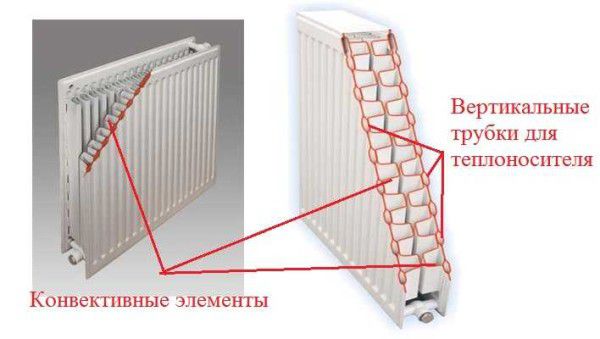
steel radiator design
But besides the design, radiators can vary greatly in size. The length of the products varies from 400 mm to 3000 mm, and the height from 200 to 900 mm. Such a variety of sizes allows you to choose the ideal radiator model, both for a standard room and for a room with large windows to the floor.
Also, when choosing such products, you need to pay attention to the type of connection: bottom or side. The choice is determined by the piping of the heating circuit. The lower connection somewhat reduces the efficiency of heat transfer, but it completely solves the issue of masking pipes. They can simply be hidden under the floor covering.

Pipes can be hidden under the floor
The advantages of panel steel radiators include:
- light weight and thickness;
- combination of direct heat transfer and convection;
- high heat transfer coefficient;
- the ability to choose a model with a different number of convectors;
- simple installation;
- affordable price (compared to a copper, bimetallic radiator);
- rapid heating of the room;
- low requirements for the quality of the coolant.
Minuses:
The lack of such batteries can manifest itself in an apartment with autonomous heating. Small in size structures, contain little water. This means that the boiler will often have to turn on in order to maintain the set temperature. This can affect the economy and energy consumption. In apartments with a central heating system, this point does not matter.
The inner surface of the steel structure often does not have a special protective coating, which increases the risk of mechanical damage from abrasive substances contained in the water. If the central heating system does not differ in the purity of the coolant, then it is unlikely that under such conditions the steel panel structure will last a long time.
Video: design features of steel panel heating radiators
Given the thin walls of the panel structure, such units do not tolerate water hammer. Therefore, if the public service “sins” with such moments, then it is better to refuse to buy these batteries. Extraneous sounds in the batteries will help to understand the presence of such pneumatic and water hammers: crackling, murmuring, clicking. If they are constantly present in the system, then you need to contact the utility service to fix these problems.
Tubular steel radiators
Unlike panel construction, tubular radiators consist of separate sections in the form of pipes. By welding, they are hermetically glued together.
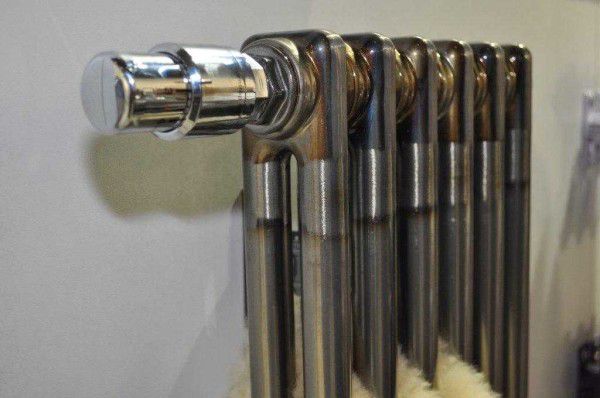
Tubular steel radiator
Such batteries are purchased ready-made in a certain size. Subsequently, they will not be able to “extend” or replace a section that has failed. In order for a tubular steel battery to provide the apartment with the necessary heat, it is necessary to calculate the power of the unit before buying, based on the area of \u200b\u200bthe room and the number of windows.
The continuity of the connection of individual pipes is an advantage and a disadvantage at the same time. Yes, on the one hand there is no way to increase the battery capacity in the future. But, on the other hand, the absence of connections excludes the possibility of leakage during an accident and strong water hammer.And this, in turn, significantly increases the reliability and service life of products.
Given the low operating pressure in tubular batteries (8-10 atmospheres), it is better to complete the design with a gearbox so that hydraulic and pneumatic shocks of the central heating system do not lead to an emergency.

Reducer helps smooth out pressure drops
Compared to panel construction, tubular models are more resistant to corrosion and abrasive substances contained in water. It's all about a special protective coating made of polymeric materials, which is applied by manufacturers to the inside of the unit.
A wide variety of tubular batteries makes it easy to choose them for apartments with any type of layout and window size. The height varies from 200 to 600 mm, the depth from 100 to 250 mm, and the length depends on the required power.
The design can include from two to 6 pipes of different sizes.
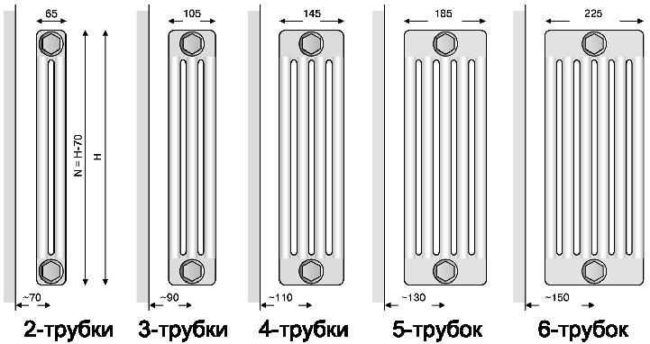
The design of the tubular radiator
- 2-pipe from 50 mm to 65 mm;
- 3-pipe from 100 mm to 110 mm;
- 4-pipe from 135 mm to 145 mm;
- 5-pipe from 170 mm to 190 mm;
- 6-pipe from 205 mm to 225 mm.
A variety of design solutions also allow you to choose the optimal model. Floor, wall, corner, vertical and horizontal - they can even be located in the center of the room. This option not only allows you to effectively warm up the room, but also visually divides it into 2 zones.

Tubular steel radiator can be given any shape
Pros:
- light weight and thickness;
- simple installation;
- corrosion resistance (compared to panel construction);
- affordable price;
- a wide variety of sizes and design solutions;
- rapid heating of the room;
- low requirements for the quality of the coolant.
Minuses:
- sensitivity to pneumatic shocks (since the elements are interconnected by welding);
- low heat dissipation.
Conclusion: for multi-storey buildings with a central heating system, experts do not recommend choosing this type of radiator.
Bimetallic heating radiators which are better for an apartment - advice from an experienced craftsman
Today, bimetallic radiators are the most popular, as they combine all the advantages of aluminum and steel structures. They are perfect for installation in apartments with central heating and their only drawback, perhaps, can only be called a high price.
Although thanks to the optimization of production capacities, a well-thought-out logistics scheme and cooperation only with trusted suppliers of raw materials, the brand STOUT manages to maintain affordable prices for all bimetallic radiators.
Heating appliances are designed specifically for our market and are successfully operated in any region of Russia. Radiators withstand pressure up to 100 atmospheres, work effectively with coolant temperatures up to 135 ° C, have a 10-year warranty from the manufacturer. Available number of sections: from 4 to 14, so you can easily select the right equipment.
What is the design feature and what material are these radiators made of?
For the production of bimetallic radiators, manufacturers use 2 types of metal: steel and aluminum. To improve the technical properties, various silicon compounds can also be added to the composition, which increase the service life and wear resistance of the batteries.
If you look inside the bimetallic radiator, we will see a two-piece design.
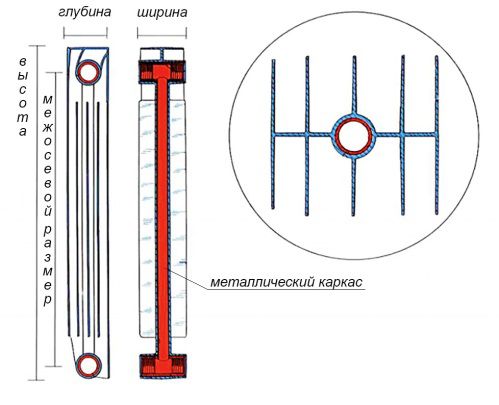
The design of the bimetallic radiator
Steel core through which the coolant circulates. The task of this core is to accumulate heat energy and transfer it to the second part, made of aluminum. It is the aluminum heat exchanger that transfers heat to the room. In addition, the aluminum casing does not come into direct contact with hot water. This task is taken on by a high-quality steel alloy. The outer part is covered with enamel paint with a protective coating, which gives the structure a stylish modern look.
The combination of the strength of steel and the high heat dissipation of aluminum allows manufacturers to produce highly efficient devices that quickly heat up a room, are not afraid of pressure drops in the system, and are resistant to corrosion.
The steel core is able to withstand a working pressure of 35-40 atmospheres. At the factory, bimetallic radiators are tested for strength, creating a pressure of 45-50 atmospheres. So, when purchasing these batteries for apartments with an unstable heating system, you don’t have to worry about the failure of the unit or creating an emergency.
In some models of bimetallic radiators, the core is made not of steel, but of copper. This is a real salvation for autonomous systems, in the coolant of which antifreeze is added. Usually this substance destroys steel products very quickly.
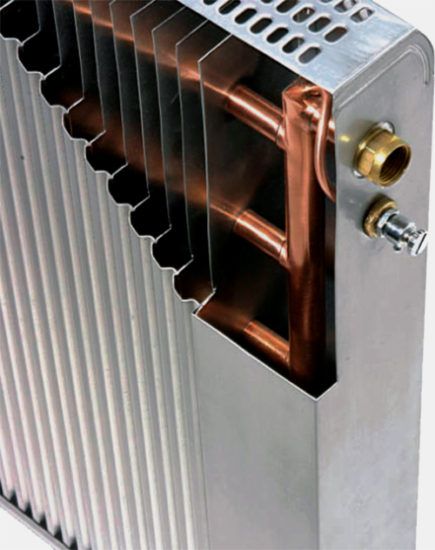
Bimetal copper core radiator
The outer panel of the radiator is a ribbed design, which improves the efficiency of heat transfer.The smooth surface with a two-layer coating provides easy maintenance, dust does not settle on them. Given the low weight of the structure, installation will not take much effort and time.
The internal part of the structure is covered with a special protective layer using polymers, which protects the radiator from the mechanical impact of abrasive substances contained in water.
Today, standard sizes of bimetallic radiators with center distances of 200, 300, 350, 500 and 800 mm are on sale. When calculating the required number of sections, be sure to focus on this parameter.
Bimetallic batteries are of two types: sectional and monolithic. Monolithic structures have a much higher price, but their technical features are much higher. The absence of joints and joints prevents leakage and breakage of products, increasing their reliability. The only caveat is that products with a solid core cannot be supplemented or reduced.
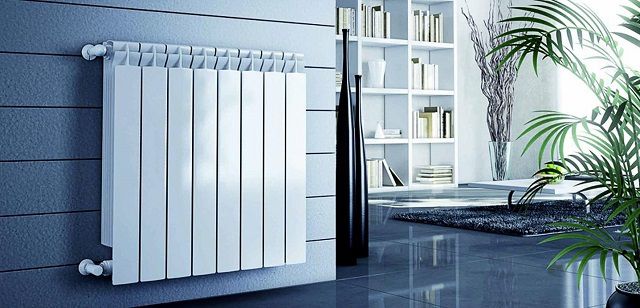
Sectional model of a bimetallic radiator
This video will help you choose the right bimetallic radiator for your apartment.
Video tips for choosing a bimetallic radiator for an apartment
Pros:
- High pressure resistant.
- High heat transfer coefficient.
- Increased resistance to water hammer.
- Low requirements for the quality of the coolant.
- Variety of design solutions.
- Light weight.
- Ease of installation.
- Stylish appearance.
- Long service life (up to 50 years).
- Ease of installation.
As mentioned above, the only downside bimetallic radiators, their high price can be called, which fully pays off with a long service life, reliability and resistance to water hammer.
In apartments with an individual heating system, where the pressure does not exceed 8-10 atmospheres, and the operating temperature is manually regulated, buying bimetallic radiators may seem like overkill. But for apartments with central heating in multi-storey buildings - this is an excellent choice.
The only thing to consider before buying is their similarity with aluminum radiators. Given that the outer casing in bimetal units is made of aluminum, you will never be able to tell the difference between the two designs without looking inside. Therefore, buy such products only in specialized stores and, of course, ask to read the technical documentation of the products before buying it.
Owner reviews (average rating 4.9 out of 5)
We found on the forum such reviews of real owners, not as an advertisement, they wrote the name of the manufacturer, so that you know what to build on.
Nikolay, Moscow.
I installed a bimetal in 2015, they seem to heat well, it’s warm in the apartment, it doesn’t blow from the windows. After calculating the required number of sections, I decided to add + 15%, I don’t know how this affected the heat transfer, but it warms my soul so much. Produced by ZHEJIANG YONGKANG SAIXI INDUSTRY. I would rate it 9 out of 10!
Sasha, Kyiv.
I connected the Russian 10-section Teplopribor BR1-500 through a thermostat, they have been standing for more than a year, they are very flat and fit perfectly into the modern design of my apartment. I have a new building, the house itself is very warm, so I chose it cleanly in appearance and so as not to flow, but I highly recommend the thermostat, a friend put it in the same house without them, so it was so fried on warm winter days)))) this summer season is going to modify them.
One of the main drawbacks is that this company is hard to find in our city. It's definitely 5 out of 5.
Copper radiators: is it worth overpaying?
This type of radiator can hardly be called popular because of its high price. But in terms of their technical characteristics, they can seriously compete with aluminum and bimetallic batteries. Such products are made from high-quality copper, without the addition of any impurities, which significantly increases their strength, flexibility and wear resistance.

copper heatsink
Copper batteries have a number of undeniable advantages:
- High efficiency (5 times higher than cast iron radiators). They heat up the room very quickly and at the same time spend minimal energy.
- Antiseptic. Copper prevents the formation and reproduction of microorganisms that are harmful to human health.
- High strength. Such units are great for apartments with a central heating system, they are not afraid of water hammer and work with a pressure of 20-25 atmospheres. The purchase of these products will be an excellent solution for an apartment in a multi-storey building.
- Possibility of use with high-temperature heat carriers. This makes copper radiators an excellent solution for climate zones with harsh winters. Copper radiator can heat up to 1400FROM.
- For apartments with independent heating, where not water, but antifreeze acts as a coolant, a copper radiator is the only right solution.
- Radiators coated with copper do not need additional processing and painting, which significantly affects heat transfer.
- High resistance to corrosion.
- Long service life.According to this parameter, radiators can only be compared with cast iron products and bimetallic batteries.
- Stylish design. The variety of sizes and styles of copper radiators allows you to harmoniously fit them into a modern interior.
- High economy. This criterion will be especially important when choosing a radiator for an apartment with an individual heating system.
Minuses:
Of the disadvantages of copper radiators, perhaps, only their considerable price and high requirements for the choice of pipe materials and the quality of the coolant can be distinguished. Such units can only be connected to a copper pipeline. Otherwise, copper will enter into a chemical reaction with another metal, which will lead to corrosion and destruction of the product. Connecting elements (fittings) must also be made of copper or brass.
How to choose the best radiator for an apartment?
Not only the technical characteristics and operating conditions of the central heating system determine the choice of batteries. There are many criteria by which it is necessary to choose radiators.
- Operating pressure. The operating pressure must be indicated in the passport of each product. Pay attention to this factor. It must exceed (at least 1.5 times) the pressure in the heating system. Taking into account the operational features of domestic utilities, it is the differences in test and operating pressure that cause the failure of modern radiators.
In five-story houses of the old layout, the average pressure in the system is usually 6-8 atmospheres. But in multi-storey buildings of modern planning, a coolant is most often supplied under a pressure of 12-15 atmospheres.
- Ability to withstand water hammer.This factor greatly affects the operational properties of batteries and their service life. It is impossible to protect yourself from water hammer in apartments with a central heating system. Therefore, it is necessary to objectively evaluate the quality of the work of your utility service and give preference to those radiators that have a sufficiently high water hammer.

Consequences of water hammer
- Number of sections. Some batteries can be "extended" during operation. Therefore, if you cannot determine the required size of the structure and doubt at this stage its heating effect, pay attention to such batteries.
- Radiator power. Of course, speaking about the practicality of radiators, we put their heating capabilities in the first place. Not all batteries can cope with maintaining an optimal microclimate in homes where the temperature outside drops to minus 40 degrees Celsius in winter. Pay attention to such a factor as the maximum temperature of the coolant. Some foreign-made models are designed for 80-90 degrees. Whereas in areas with severe winters, it is better to select products with a maximum temperature of 120-130 degrees.
- The composition of the coolant. Almost all Russian utilities cannot boast of the high quality of the coolant, which wears out the walls of the battery. Therefore, when choosing, consider this factor and select radiators with thick walls.
- Product design and decoration. This is, of course, a subjective factor. But, you see, when choosing batteries for an apartment with a modern renovation, you no longer want to install a bulky Soviet-style design, given the rich assortment of radiators on the market.

Modern radiators can have the most bizarre designs.
- Lifetime. This factor again depends on the working conditions and on the technical features of the utility service. Replacing batteries in an apartment is not the cheapest event, so when purchasing a new set of radiators, make sure that they serve you for at least 20-25 years.
- Ease of installation. This criterion is only important if you will install the batteries yourself. You cannot install a heavy cast iron structure alone, but even a beginner can easily install light panel radiators.

Battery mounting
Summing up, we can make the following brief description of radiators for all their technical properties:
Brief description of radiators
| Type of radiator | Limit t °C | Operating pressure | Lifetime | Power 1 section |
|---|---|---|---|---|
| Cast iron | up to +150 °C | up to 15 atm | up to 50 years | 80-160W |
| Aluminum | up to 110 °C | 10-15 atm | 10-15 years old | 82-212W |
| Steel panel | up to 110 °C | 8-10 atm | 12-15 years old | 90-212W |
| Steel tubular | up to 120 °C | 15-20 atm | 15-20 years old | 90-212W |
| Bimetallic | 100°C | 30-35 atm | up to 50 years | 170-190W |
| Copper | up to 140 °C | 20-25 atm | up to 50 years | 180-200W |
So, when choosing radiators for an apartment, always consider the features of the heating system. Don't skimp on these products. A low price can not only cause an emergency in the house, but is also unlikely to help create a comfortable microclimate in the house.
At the end of this article, we suggest that you familiarize yourself in detail with the various types of radiators presented today on the market using video instructions:
Video instruction for choosing heating radiators for an apartment

